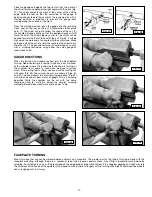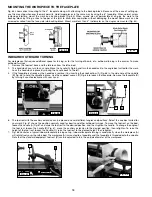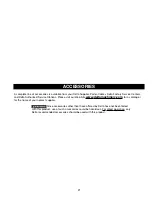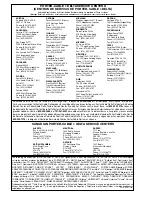
13
TOOL REST POSITION
Mount the tool rest in place about 1/8” away from the work
and 1/8” above the work centerline (Fig. 32.) This position may
vary to suit both you and the work. Place a guide mark on the
tool rest shank as an aid to quick and accurate resetting.
Clamp the tool rest firmly before operating
the lathe.
Fig. 32
ROUGHING A CYLINDER
The large gouge is used in the first turning operation by
smoothing the sharp corners of the work. Run the lathe at low
speed and hold the gouge in the manner shown in Fig. 33 The
cut starts about 2 inches from the tailstock end and continues
from this point to the end of the tailstock. Make the second pass
beginning about 2” or 3” to the left of the first cut. Advance
again toward the tailstock, and merge with the previous cut.
Toward the end of the live center, roll the gouge in the opposite
direction (Fig. 34) to carry the final cut off the live center end of
the work. The roughing cut should not be carried out with one
continuous movement, because this would tear long slivers
from the corners of the work. Neither should the cut be started
directly at the end of the stock for the same reason. You can
safely carry the cut from the center of the stock toward and off
either end once the first roughing cuts have been made.
The position of the gouge involves two or three important
angles. (1) Advance the tool along the work either from right to
left or from left to right. Left to right (from headstock to tailstock)
is preferred since this action throws chips clear of the operator.
(2) Roll the gouge over slightly in the same direction that it is
advancing. (3) Hold the tool well up on the work, with the bevel
to the revolving surface (Fig. 35). This position will give a clean
shearing cut. When pushed straight into the work (Fig. 35), the
gouge has a scraping action, (normally a poor practice in spindle
turning). Continue the roughing cut until the work approaches
1/8” of the required diameter. Once a cylindrical form has been
obtained, you can change the turning speed to the second or
third speed setting.
NOTE:
Continue to move the tool rest inward toward the work
piece to keep the safe distance between the two.
Fig. 33
Fig. 34
Fig. 35
POSITION OF HANDS
While turning, the hand that holds the tool handle should be in a
natural position. This hand provides the leverage for the tool by
either moving in toward the workpiece or moving out. The
position of the tool rest hand is more a matter of individual
preference, rather than a “set” or “proper” position. However, a
palm-up grip (Fig. 36) is generally considered best. In this
position, the first finger acts as a guide, sliding along the tool
rest as the cut is made. The alternate position is a palm-down
grip (Fig. 37). In this position, the heel of the hand or the little
finger serves as a guide. The palm-down position is solid and
positive – excellent for roughing or heavy cutting. Most
beginners start with the palm-down grip, switching later to the
palm-up position for better manipulation of the chisel.
Fig. 36
Fig. 37
Summary of Contents for 46-715
Page 23: ...23 NOTES...





































